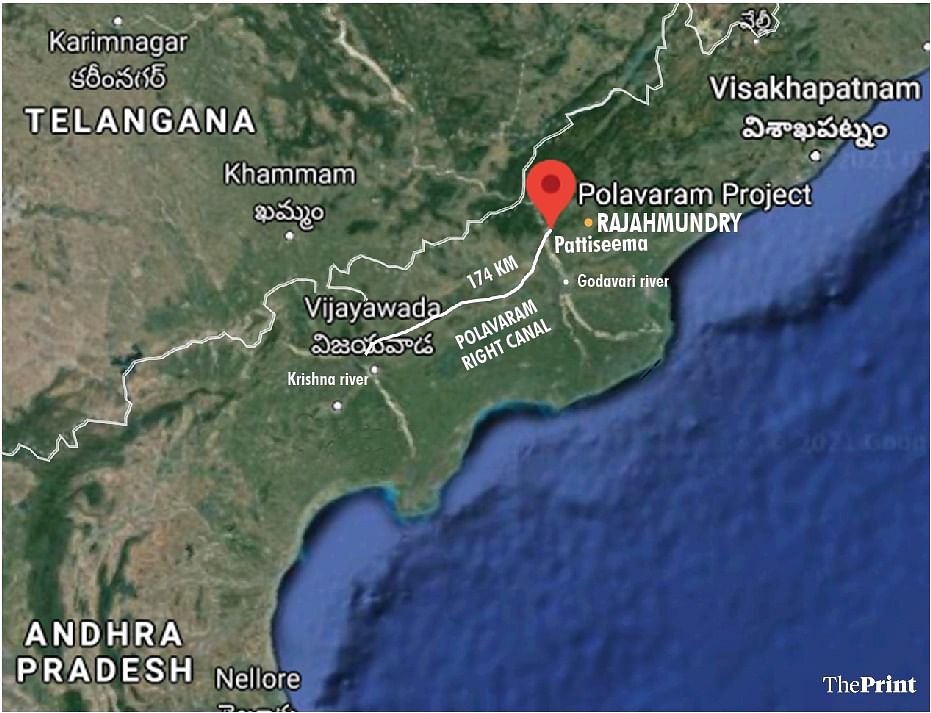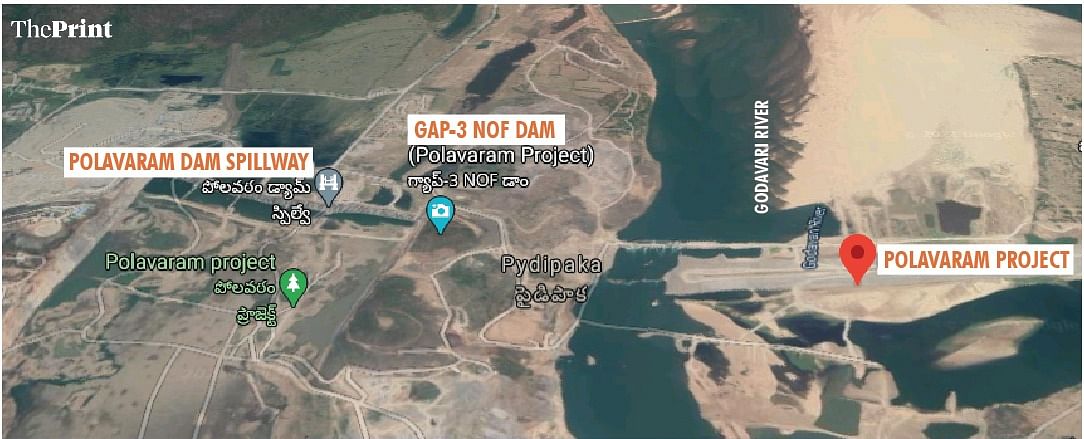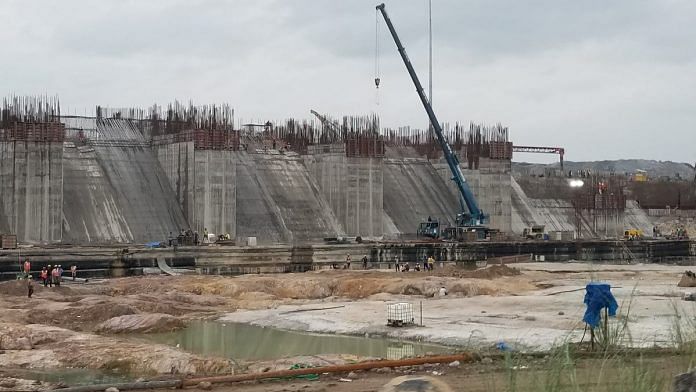Hyderabad: Eighty years since it was first proposed by the chief engineer of the then Madras Presidency’s Irrigation Department, and 17 years after the late former chief minister of Andhra Pradesh, Y.S. Rajasekhara Reddy (YSR), green-lighted it, the Polavaram irrigation project on the mighty Godavari has been swimming against the high tide of missed deadlines, cost overruns, and disagreements between the Centre and the state.
And it is unlikely to be completed by April 2022 (the revised target date), despite being the dream project of YSR’s son and incumbent Chief Minister Y.S. Jagan Mohan Reddy (Jagan), whose party has bailed out the Narendra Modi government on critical occasions in the days when it used to be in a minority in the Rajya Sabha.
Polavaram has become the bone of contention between Jagan and the Modi dispensation. And state officials in the know of things fear the project cost estimate, which has already ballooned about five-fold since 2004-05, will touch Rs 65,000 crore by the next financial year, up from Rs 55,000 crore agreed upon after much jostling by the Union Jal Shakti Ministry.
Consider the odds stacked against the project billed as the ‘Lifeline of Andhra Pradesh’ — and projected to irrigate 2.91 lakh hectares (thus promising to make the state drought-free), generate 960MW of hydro power, and provide drinking water to 28.5 lakh people in 540 villages and Visakhapatnam city.
- A mere 3,417 families (or 3.3 per cent) of the 1.05 lakh families to be displaced by the project have been relocated. The state government aims to shift 17,453 families (approx. 17 per cent) by May.
- No funds have been set aside for the project in the 2021-22 Union Budget, even after the Jal Shakti ministry had agreed, following protracted bureaucratic wrangling, to the revised estimate of Rs 55,000 crore pegged for it by the state government.
- There’s also no certainty about the allocation getting finance ministry approval — and if it does, it is unlikely the project can be completed by the April 2022 deadline, set by Jagan, and announced in the Rajya Sabha by the Minister of State for Jal Shakti, Rattan Lal Kataria, on 9 March.
- And the big spanner in the works is that the funds will be available on a ‘reimbursement only’ basis against money actually spent by the state government, which is cash-strapped, according to the engineer-in-chief of its Irrigation Department, and therefore not in a position to pay.
The Andhra Pradesh Reorganisation Act of 2014 accorded the project national status, making it mandatory for the central government to pick up the tab, which was Rs 10,151 crore when YSR brought it to life in 2004-05.
But the money does not come easily. It takes a circuitous eight-step route to reach the state government. Its expenditure statements first go to the Polavaram Project Authority (PPA), from there to the Jal Shakti ministry, which passes them on to the finance ministry for it to authorise the National Bank for Agriculture and Rural Development (NABARD) to raise a loan credited to the National Water Development Agency (NWDA). The agency finally transfers the money to the PPA for onward movement to the state government.
The reimbursement process has indeed become an irritant. Complaining about it to the Jal Shakti ministry, Jagan wrote in a letter in September 2020: “The delay caused by this circuitous and complicated process has an adverse impact on the finances of the state, which is already [facing a] revenue deficit due to the bifurcation, and it is difficult for the state to bear the expenditure upfront and claim reimbursement.”
The system, however, remains unchanged.
Also Read: Monday storm for Polavaram as Modi govt caps project cost to half, angers Andhra
Central govt at odds with state
Located near Ramayyapeta village of the Polavaram mandal in the West Godavari district, about 42 km upstream of Sir Arthur Cotton Barrage, the project never took off, even though it was first proposed in 1941, because earlier governments lacked either the money, or the political will to confront the matter of relocation of displaced families.

Leadership changes in the state, companies managing the project lapsing, pending reimbursements and disagreement of cost estimates exacerbated the delay.
Even after the project received its national status, it got stuck because the state and the central government were at loggerheads over project costs and the responsibility of footing the bill for the rehabilitation of the 1.05 lakh affected families. The central government is committed to picking up the tab for only the irrigation component of the project.
“The main hurdle is the Centre’s refusal to accommodate the rehabilitation package,” said Akkineni Bhavani Prasad, general secretary, Kisan Service Organisation, Andhra Pradesh.
“Land acquisition and rehabilitation now account for more than 50 per cent of the project cost. Both governments have been dealing with the issue politically. If this continues, it will take up to 2025 for the project to be completed.”
The state government blames the central government for its relief and rehabilitation migraine. According to Narayana Reddy, engineer-in-chief of the Andhra Pradesh government’s Irrigation Department, the primary reason for the project cost shooting up is the sharp increase in the land acquisition and relief and rehabilitation components because of the Land Acquisition Act 2013 brought by the Manmohan Singh government.
It increased the number of families to be rehabilitated from 44,000 in 2005-06 to 1.05 lakh in 2020.
“The previous (Chandrababu Naidu) government completely ignored the land acquisition and rehabilitation part, although this forms almost 50 per cent of the project. There were loopholes in the construction part too — which took an entire season to be rectified, causing more delay,” a senior official from the state government told ThePrint on condition of anonymity.
Also Read: Andhra govt won’t accept capped cost of Polavaram project, to urge Centre to revise amount
Contentious cost estimates
The project cost estimate, meanwhile, shot up to Rs 55,548 crore in 2017-18, from Rs 10,151 crore in 2004-05 and Rs 16,010 crore in 2010-11. The Revised Cost Committee, comprised of experts on Polavaram, reset the projected cost to Rs 47,725.74 crore.

In the intervening years, YSR passed away in 2009 and the state was split in 2014. That year, N. Chandrababu Naidu became the state’s first chief minister after reorganisation and set 2019 as Polavaram’s completion date.
In November 2020, the Jal Shakti ministry capped the project fund approval to Rs 20,398.61 crore, based on the 2013-14 estimate, which had been accepted by Naidu without taking into account the land acquisition and relief and rehabilitation costs. It made Jagan see red. He shot off a letter to Prime Minister Narendra Modi seeking his intervention, describing the cost revision as an “embarrassment”.
Jagan pointed out in his letter that the cost of land acquisition and relief and rehabilitation alone was Rs 28,191.03 crore out of the revised cost estimate of Rs 47,725.74 crore authorised by the empowered committee.
Capping the expenditure at Rs 20,398.61 crore at 2013-14 prices for the irrigation component only, therefore, was unrealistic and at variance with the central government’s earlier commitments and guidelines for national projects, Jagan argued. He described it as a violation of the 2014 Act.
The state government is also unhappy about the ‘reimbursement only’ policy of the ministry. Narayana Reddy, the irrigation department chief engineer, said: “Polavaram has been declared a national project, so the Centre must give funds upfront, in advance, but it has decided to reimburse only the money that the state spends on the project. The state is already financially burdened. From where will it get the money? And then the Centre is taking its own time to reimburse the spent amount.”
The Jagan government, however, faces criticism from the Opposition for spending recklessly on the chief minister’s ‘welfare schemes’. According to Telugu Desam Party (TDP) leader Kutumba Rao, the Jagan government spent a significant part of its budget for the welfare schemes instead of spending them on developmental works. He added that rehabilitation works take “years” to be done.
The state government has spent about Rs 80,000 crore in the last 20 months on Jagan’s freebie schemes such as YSR Pension for senior citizens, YSR Rythu Bharosa, financial assistance for farmers, and Jagananna Amma Vodi, a scheme where every mother is provided with financial assistance of Rs 15,000 every year to educate her child from Class 1 to 12 in public and private schools.
“From 2019 March till now, there has been only 6 per cent progress in the project works,” Kutumba Rao told ThePrint.
Up until January this year, the state government had spent about Rs 17,122.89 crore on the project. Of this, it had expended Rs 12,392.18 crore after the project was accorded national status on 1 April 2014, but the central government has only reimbursed Rs 10,741.46 crore through the Polavaram Project Authority (PPA).
And though the state government recently asked the Centre for the remaining Rs 1,650 crore, the PPA recommended that only Rs 333 crore be paid, according to a March 2021 report. In the past, the PPA rejected bills adding up to Rs 760 crore, citing ineligibility.
The upshot of this Centre-state slugfest is that the project is in limbo, even as a higher cost estimate and the daunting task of rehabilitating the remaining 80 per cent of the 1.05 lakh families remains undone. The ‘Lifeline of Andhra Pradesh’ is in desperate need of life support.
(Edited by Sunanda Ranjan)
Also Read: How the business of water scarcity can be tackled in India



